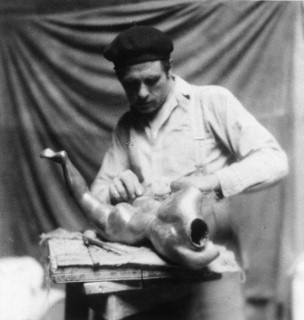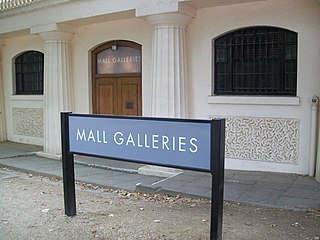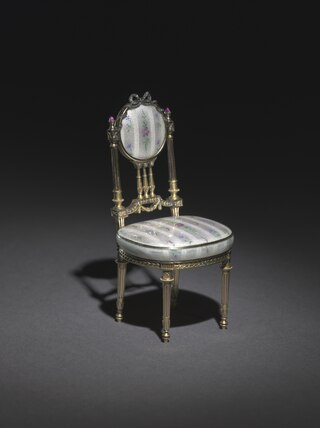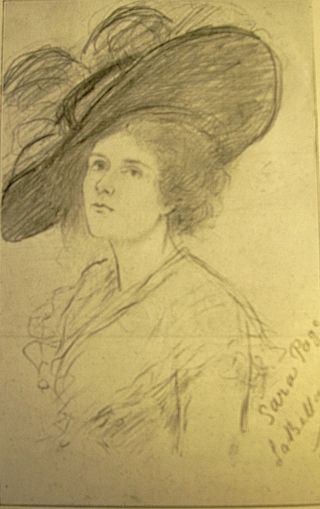Related Research Articles

The Victorian Artists Society, which can trace its establishment to 1856 in Melbourne, promotes artistic education, art classes and gallery hire exhibition in Australia. It was formed in March 1888 when the Victorian Academy of Arts and the Australian Artists' Association amalgamated.

The Royal Academy of Arts (RA) is an art institution based in Burlington House in Piccadilly in London, England. Founded in 1768, it has a unique position as an independent, privately funded institution led by eminent artists and architects. Its purpose is to promote the creation, enjoyment and appreciation of the visual arts through exhibitions, education and debate.

Sarah Biffen, also known as Sarah Biffin, Sarah Beffin, or by her married name Mrs E. M. Wright, was an English painter born with no arms and only vestigial legs. She was born in 1784 in Somerset. Despite her disability she learned to read and write, and to paint using her mouth. She was apprenticed to a man named Dukes, who exhibited her as an attraction throughout England. In the St. Bartholomew's Fair of 1808, she came to the attention of George Douglas, the Earl of Morton, who went on to sponsor her to receive lessons from a Royal Academy of Arts painter, William Craig. The Society of Arts awarded her a medal in 1821 for a historical miniature and the Royal Academy accepted her paintings. The Royal Family commissioned her to paint miniature portraits of them. When the Earl of Morton died in 1827, Biffen was left without a noble sponsor and she ran into financial trouble. Queen Victoria awarded her a Civil List pension and she retired to a private life in Liverpool. She died on 2 October 1850 at the age of 66.

George Claude Leon Underwood was a British artist, although primarily known as a sculptor, printmaker and painter, he was also an influential teacher and promotor of African art. His travels in Mexico and West Africa had a substantial influence on his art, particularly on the representation of the human figure in his sculptures and paintings. Underwood is best known for his sculptures cast in bronze, carvings in marble, stone and wood and his drawings. His lifetime's work includes a wide range of media and activities, with an expressive and technical mastery. Underwood did not hold modernism and abstraction in art in high regard and this led to critics often ignoring his work until the 1960s when he came to be viewed as an important figure in the development of modern sculpture in Britain.

Levina Teerlinc was a Flemish Renaissance miniaturist who served as a painter to the English court of Henry VIII, Edward VI, Mary I and Elizabeth I. She was the most important miniaturist at the English court between Hans Holbein the Younger and Nicholas Hilliard. Her father, Simon Bening, was a renowned book illuminator and miniature painter of the Ghent-Bruges school and probably trained her as a manuscript painter. She may have worked in her father's workshop before her marriage.
Magda Szabo is a Canadian miniaturist.

The Federation of British Artists (FBA) consists of nine art societies, and is based at Mall Galleries in London where the societies' Annual Exhibitions are held. The societies represent living artists working in the United Kingdom who create contemporary figurative art. Mall Galleries aim to 'promote, inspire and educate audiences about the visual arts.'

Miniature art includes paintings, engravings and sculptures that are very small; it has a long history that dates back to prehistory. The portrait miniature is the most common form in recent centuries, and from ancient times, engraved gems, often used as impression seals, and cylinder seals in various materials were very important. For example most surviving examples of figurative art from the Indus Valley civilization and in Minoan art are very small seals. Gothic boxwood miniatures are very small carvings in wood, used for rosary beads and the like.

Vincent Michael Brown is an English artist and portrait painter, composer and musician, and co-founder of Browns' Arts Centre, an art school and studio located at The Clock Tower Association in Warmley, Bristol.

Sara Wells Page (1855–1943) was a British artist, portrait and figurative painter, of the Victorian and Edwardian period. During her lifetime she was widely exhibited at Parisian salons and British galleries, including the Royal Academy of Arts. Three of her paintings are in Wolverhampton Art Gallery.

The Society of Women Artists (SWA) is a British art body dedicated to celebrating and promoting fine art created by women. It was founded as the Society of Female Artists (SFA) in 1855, offering women artists the opportunity to exhibit and sell their works. Annual exhibitions have been held in London since 1857, with some wartime interruptions.
The International Society of Sculptors, Painters and Gravers was a union of professional artists that existed from 1898 to 1925, "To promote the study, practice, and knowledge of sculpture, painting, etching, lithographing, engraving, and kindred arts in England or elsewhere...". It came to be known simply as The International. The society organised exhibitions, some for members only and some open to others, and social events such as musical evenings and soirées. The exhibitions were held in a number of London venues, and in other cities around England, including Nottingham and Manchester. Its founder and first president was James McNeill Whistler. On his death, the presidency was taken up by Auguste Rodin, with John Lavery as vice-president. The society contributed £500 towards the cost of Whistler's memorial.

The Grafton Galleries, often referred to as the Grafton Gallery, was an art gallery in Mayfair, London. The French art dealer Paul Durand-Ruel showed the first major exhibition in Britain of Impressionist paintings there in 1905. Roger Fry's two famous exhibitions of Post-Impressionist works in 1910 and 1912 were both held at the gallery.

Emil Fuchs was an Austrian–American sculptor, medallist, painter, and author who worked in Vienna, London and New York. He painted portraits of Queen Victoria and Edward VII and was fashionable among London high society in the early 20th century.
Chrysoula Argyros is a South African artist who paints in watercolors and oils. Chrysoula's chosen subjects are generally portraits, Greek scenes, old buildings and people.

Cathie Pilkington is a London-based British sculptor represented by Karsten Schubert London. She studied at Edinburgh College of Art and the Royal College of Art, and was elected as a Royal Academician in 2014. She became professor of sculpture at the Royal Academy Schools in 2016.

Anne Marjorie Robinson, sometimes Annie Marjorie Robinson, (1858–1924) was a British painter who also exhibited examples of her sculptures and miniatures.
Raoof Haghighi is an Iranian-born British artist, known for his portraiture and realism.
Barbara Tribe (1913–2000) was an Australian-born artist who spent most of her career in Cornwall. She is regarded as a significant twentieth-century portrait artist, working both in painting and sculpture.

Hilda Annetta Walker FRSA was an English sculptor, and a painter of landscapes, seascapes and horses, flourishing between 1902 and 1958. She was a war artist painting in England during the First and Second World Wars, and described as "escapist". Some of her early work was the production of oilette postcard paintings for Raphael Tuck & Sons, of firemen and horses. She was born in Mirfield, Yorkshire, England, to a family of blanket manufacturers who had the means to foster her art education. She grew up in the Protestant work ethic of Congregationalism, and attended Leeds College of Art, where she studied under William Gilbert Foster of the Staithes group and William Charles Holland King, sculptor of Dover Marine War Memorial. She signed her works "Hilda Walker" or sometimes "Hilda A. Walker".
References
- ↑ "THE ROYAL SOCIETY OF MINIATURE PAINTERS SCULPTORS AND GRAVERS - Charity 291389". register-of-charities.charitycommission.gov.uk. Retrieved 29 November 2020.
- ↑ "Royal Society of Miniature Painters, Sculptors and Gravers". www.royal-miniature-society.org.uk. Retrieved 29 November 2020.
- ↑ "The Royal Society of Miniature Painters Sculptors and Gravers | Prince of Wales". www.princeofwales.gov.uk. Retrieved 29 November 2020.
- 1 2 "The Renaissance of Miniature Painting". www.royal-miniature-society.org.uk. Retrieved 15 January 2021.
- ↑ "Royal Miniature Society Members". www.royal-miniature-society.org.uk. Retrieved 29 November 2020.
- ↑ "Ray Winder PRMS". www.royal-miniature-society.org.uk. Retrieved 29 November 2020.
- ↑ "Royal Society of Miniature Painters Sculptors and Gravers 2019". Mall Galleries. 30 April 2019. Retrieved 29 November 2020.
- ↑ "Big money for small art". The Independent. 5 November 1995. Retrieved 30 November 2020.
- ↑ "Elena Baranoff Exhibitions & Awards". www.elenabaranoff.com. Retrieved 30 November 2020.
- ↑ "BIOG". website-1. Retrieved 30 November 2020.
- ↑ "Award winners". www.royal-miniature-society.org.uk. Retrieved 29 November 2020.
- ↑ "Big money for small art". The Independent. 5 November 1995. Retrieved 29 November 2020.
- 1 2 3 "Submitting Artwork". www.royal-miniature-society.org.uk. Retrieved 29 November 2020.
- 1 2 Tait, Simon. "Modern heirs of a tradition of vellum and cinnabar". The Times . ISSN 0140-0460 . Retrieved 29 November 2020.
- ↑ "history of miniature painting". www.royal-miniature-society.org.uk. Retrieved 29 November 2020.
- ↑ "Gallery". Archived from the original on 8 October 2011. Retrieved 12 September 2009.
- ↑ Back from Hell - Gallery of portraits by John Mennie
- ↑ Lucas Art The Royal Society of Miniature Painters Sculptors and Gravers - One Hundred Years. (London, 1995). ISBN 0-9520456-9-9
- ↑ Eleanor Tufts; National Museum of Women in the Arts (U.S.); International Exhibitions Foundation (1987). American women artists, 1830–1930. International Exhibitions Foundation for the National Museum of Women in the Arts. ISBN 978-0-940979-01-7.